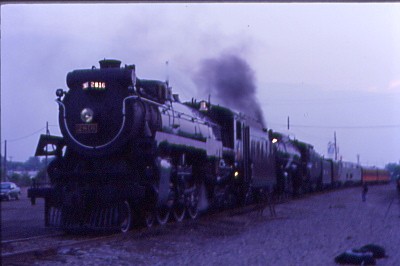
This was one of the train trips during the Grand Excursion, a promotional voyage by train and steamboat into the Upper Mississippi River valley, that first took place in June 1854. It marked the first railroad connection between the East Coast and the Mississippi River. In 2004, 150 years later, the Grand Excursion route was retraced.
Built by the Montreal Locomotive Works in December 1930, it is the only non-streamlined Hudson to be preserved. The locomotive was primarily used in pulling passenger trains in revenue service for thirty years before it was retired in May 1960. In 1963, it was sold to F. Nelson Blount, who added it to his Steamtown, U.S.A. collection in Bellows Falls, Vermont. After becoming surplus in the collection by the National Park Service, 2816 was reacquired by the Canadian Pacific in 1998 and crews from BC Rail were hired to extensively restore it to operating condition.
Revenue serviceIt was first assigned to premier passenger service between Winnipeg and Fort William, Ontario. Following the introduction of semi-streamlined Royal Hudson locomotives in 1937, it was re-assigned to secondary passenger service between Windsor, Ontario and Quebec City and during the 1950's, it pulled commuter trains between Montreal and Rigaud, Quebec. In 1957, 2816 received a minor overhaul, with its tender being replaced with one from Royal Hudson 2822. The locomotive was retired from revenue service on May 26, 1960, after accumulating 2,046,000 miles and was subsequently used briefly as a stationary boiler at the St. Luc yards in Montreal.
Steamtown ownershipIn the early 1960's, F. Nelson Blount wanted to expand his Steamtown, U.S.A. collection and one of the locomotives he initially wanted to preserve was a 4-6-4 from the New York Central Railroad. Since all NYC 4-6-4s were scrapped by that time, Blount improvised by purchasing 2816 from the Canadian Pacific in December 1963. The locomotive was removed from the scrap lines of Angus, Ontario, and it was put on static display at Steamtown's first location in Bellows Falls, Vermont. During No. 2816's time on static display, the locomotive deteriorated from the outdoor elements and its condition worsened for several years. In the winter of 1983-1984, it was moved along with the rest of the collection to Scranton, Pennsylvania, where Steamtown was later reorganized as Steamtown National Historic Site under the ownership of the National Park Service. Following the reorganization, 2816 was deemed surplus in the collection and Steamtown wanted to dispose of it.
RestorationDuring the mid to late 1990's, the Canadian Pacific Railway's then-president and CEO, Robert Ritchie, reorganized the company and established the "Royal Canadian Pacific" excursion train to honour the railway's history and he sought for Canadian Pacific to operate their own steam excursion program. In 1998, the Canadian Pacific purchased 2816 from Steamtown and in exchange, the railway would move some equipment to Scranton. Canadian Pacific had heard of its availability via phone calls from BC Rail, who had been operating Canadian Pacific Royal Hudson 2860 as part of their own excursion program; the 2860 crews had been looking for replacement parts for the Royal Hudson and were offered to buy the entire locomotive by Steamtown.
A team of inspectors performed a preliminary inspection on 2816, and they pronounced that it was in good condition. In September 1998, the locomotive was coupled in a special consist led by Canadian Pacific GP38-2 3069, FP7 1400 and St. Lawrence and Hudson GP9u 8216, and it was ferried from Scranton to Montreal via Binghamton and Albany, New York, before travelling cross-country to the BC Rail steam workshop in North Vancouver, British Columbia. Canadian Pacific contracted the BC Rail steam shop crew, led by Al Broadfoot, to disassemble the steam engine and evaluate its condition; if it were salvageable, then they would restore it to operating condition, but if it were deteriorated beyond salvaging, then they would give it a cosmetic restoration for static display purposes.
When 2816 was disassembled, it was revealed that it was mechanically worn out, despite the preliminary inspectors having stated otherwise, but Rob Ritchie decided to approve a complete rebuild of the locomotive, regardless. Broadfoot and his team were able to obtain multiple plans and vital information about Canadian Pacific H1b class locomotives, including a collection of over 800 technical drawings provided by the Canada Science and Technology Museum and they used them as references for the project. Hundreds of replacement parts had to be fabricated by contractors in Vancouver, such as the cab, the running boards, the rod brasses, the superheater manifold, among others.
Contractors in the United States were hired to overhaul other major parts of 2816; the driving wheels were shipped to the Tennessee Valley Railroad Museum in Chattanooga, Tennessee and the boiler was shipped to Doyle McCormack and his crews in Portland, Oregon. 2816's firebox was converted from coal to oil firing and the tender received dual water intakes with Canadian and American threads. Canadian Pacific gained so much faith in the project that on April 19, 2000, the railway announced that it would be scheduled to return to service for their steam program by September of that year, but the deadline was pushed back, due to further challenges encountered in the restoration process. The project spanned more than two years and incurred costs between $3 million and $3.5 million.
Canadian Pacific excursion service and temporary hiatusOn August 15, 2001, 2816 passed its federal boiler inspection, and the following day, the locomotive was fired up for the first time in forty years, performing a series of test runs over three days on Canadian Pacific's Cascade Subdivision between Coquitlam and Mission. From September 19 to 23, with Al Broadfoot as the fireman and with Bill Stettler and Doyle McCormack taking turns as the engineer, 2816 pulled its first official inaugural excursion out of Port Moody, toured some of the Canadian Pacific mainlines for 672 miles over five days and then it stopped at Canadian Pacific's headquarters in Calgary, Alberta. The locomotive began pulling additional public relations excursions for the Canadian Pacific Railway, and it quickly received the name "The Empress".
On May 16, 2002, the locomotive pulled two excursions for the West Coast Express. Between May 24 and July 8, 2003, 2816 toured the Canadian Pacific between Alberta and Ontario, and the purpose of the tour was to spread further public awareness of Canadian Pacific and to raise money for the children's "Breakfast for Learning" program. On September 27, 2816 visited the Kamloops Heritage Railway and took part in a doubleheader excursion with Canadian National 2-8-0 2141. In May 2004, 2816 pulled the Royal Canadian Pacific consist while performing a 3,000-mile tour across the Canadian Pacific between Vancouver and Montreal, and it marked the first time in fifty years that a single steam locomotive pulled a cross-country passenger train in Canada, but it was assisted by three Canadian Pacific heritage diesels.
In early June 2004, the Empress was ferried behind a Soo Line SD60 over the CSX mainline between Buffalo, New York and Chicago, Illinois, hen it travelled to the Twin Cities area in Minnesota to participate in the Grand Excursion 2004 event, which celebrated the 150th anniversary of the Chicago and Rock Island Railroad's celebration train of 1854. 2816 pulled multiple public excursions for the event between the Twin Cities and the Quad Cities area in Iowa, using passenger coaches owned by Friends of the 261 and the last train took place on July 3; a doubleheader with Milwaukee Road 261 from St. Paul to La Crescent and return. 2816 returned from Minnesota to Calgary with a charity train later that same month.
Built by the American Locomotive Company in July 1944, 261 was originally operated by the Chicago, Milwaukee, St. Paul & Pacific Railroad, which was also known as the Milwaukee Road. The locomotive, weighing 460,000 pounds, is rated at a maximum of 4,500 hp and maximum speed of 100 mph is coal fueled. It had a 3 chime whistle and airhorn mounted on it. It operated with the railroad until retiring in 1954, and eventually donated to the National Railroad Museum in Green Bay, Wisconsin. As the new museum's first acquisition, 261 was moved to the museum site in 1958.
In 1991, the newly formed "North Star Rail" selected 261 for restoration for mainline excursions for a variety of reasons. The engine was large enough to handle the expected trains at track speed, it featured several modern features for a steam locomotive, including easier to maintain roller bearings, and it also already had its asbestos lagging removed, which is very expensive to remove for environmental and safety reasons. Finally, 261's relatively short 10-year service life meant that the engine's boiler is more pristine, meaning it would take less work to rebuild the engine.
North Star Rail and the National Railroad Museum came to an agreement in November 1991 for a ten-year lease (which was later renewed ten years later). 261 was moved from Green Bay to Minneapolis to the GE shops at Humboldt Yard in September 1992. There, a full-time staff rebuilt the engine. Work progressed quickly, allowing for a hydrostatic test in June 1993, a test fireup in July, and the eventual restoration completion in September. After passing the FRA inspection on September 14, the engine deadheaded over Wisconsin Central in time for its first public excursions on September 18-19, 1993. The engine later returned to its new home at the leased Burlington Northern Minneapolis Junction.
The following year, 261 had an extensive season including excursions on the Wisconsin Central Railroad and the Twin Cities and Western Railroad. Notable events included "Chocolate City Days" excusions, campaign trains, a movie shoot painted as "Lackawanna 1661", running over CSX tracks for the famed "New River Train", and a wrap up celebrating the engine's 50th birthday.
The engine participated in the Steamtown National Historic Site's grand opening in July 1995. Over five days, 261 deadheaded from Minneapolis to Scranton, Pennsylvania. The locomotive stayed in Scranton for the next year pulling numerous excursions, including rare mileage trips, a rare snow plow run, and the engine's first steam doubleheader with Susquehanna 142. A Hancock 3 chime whistle was temporarily added to the locomotive and then replaced with an AT&SF 6 chime whistle, which it remains with today, but still also keeping its original non-Hancock 3 chime whistle and airhorn. 261 returned to the Midwest after almost a year at Steamtown. On its way home, the engine made its first runs over the newly formed Burlington Northern Santa Fe Railway. It pulled a few sets of excursions in 1997 and 1998 over BNSF and TC&W trackage.
The year of 1998 presented 261 on its biggest assignment yet as it was the first steam engine to pull BNSF's Employee Appreciation Special. The engine led a BNSF locomotive and a dozen of BNSF's business fleet around the upper Midwest portion of the BNSF's route. This brought the engine back to Chicago before heading north to North Dakota and Montana, then through Minneapolis into Iowa before the EAS concluded at Topeka Railroad Days. 261 ended the 1998 operating season after a few more days on BNSF tracks going from North Kansas City to Lincoln to Sioux Falls back to the Twin Cities on a Camerail Club Excursion.
The 1999 season was short with a weekend excursion in May from Minneapolis to Duluth along with runs on the Lake Superior Railroad Museum's tracks, along with another excursion in September. The year 2000 saw 261 leading excursions out of places like Chicago, Omaha and Kansas City. The engine also led an AAPRCO special on August 29 to Duluth. The engine then led a long circle trip over the Duluth, Missabe and Iron Range Railroad as well as the North Shore Railroad System before heading back home. The 2001 season had excursions out of Minneapolis and Montevideo over BNSF and TC&W tracks during June and July, in a complete match of Hiawatha passenger cars. The next year, 261 pulled an almost matching consist between Minneapolis and Chicago. At this point, insurance rates were skyrocketing due to outside events as well as new FRA guidelines. The Friends of the 261 had an insurance policy to run through 2002, making these trips among the last time that the group could afford to have 261 run solo.
In the following months, some major changes were made to the Friends of the 261's operations. With insurance being too high to charge reasonable ticket prices, the group decided to team up with Amtrak. Amtrak is self-insured, so the added cost of excursion insurance was much less. However, Amtrak requires that all equipment meet Amtrak certification. The engine became the second steam engine to become Amtrak certified, and the Friends of the 261 began to buy or rebuild coaches that would meet Amtrak specifications. The first team up with Amtrak occurred in October 2003 with the engine's return to old Milwaukee Road tracks between Minneapolis to Winona, Minnesota. These trips have been repeated each year since.
The ChaseBob Riskie and I arose well before the sun and Dennis Larsen picked us up at 5:05 AM and we drove to Minneapolis Junction where we found Canadian Pacific 2816 on the point of Milwaukee Road 261's train. I chose a location and several other photographers joined me.
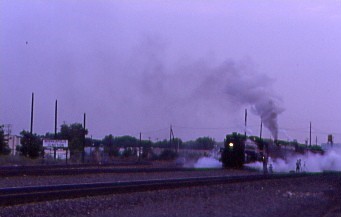
As soon as the train started to move two photographers kept running in front of the train getting into everyone's pictures. Two very rude people wrecked all the other people's pictures.
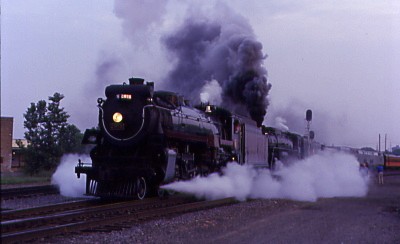
I made a quick move and relocated watch this incredible departure. Once "Cedar Rapids" passed, we went up Central Avenue by Shoreham Yard to a Denny's for breakfast then drove to St. Paul in plenty of time.
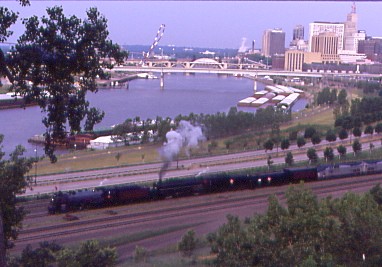
We therefore went to Mounds Park on Dayton Bluff for the departure with St. Paul and the Mississippi River in the scene. A red signal assisted us to our next location.
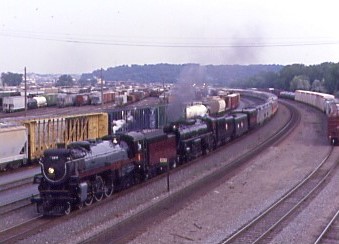
We drove to Canadian Pacific's Pig Eye Yard and went up on the walkway over the yard for our next runby.
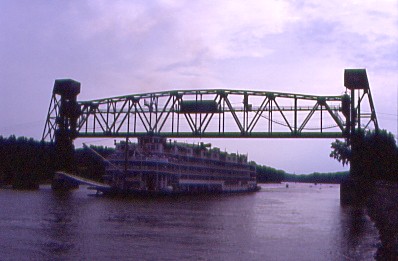
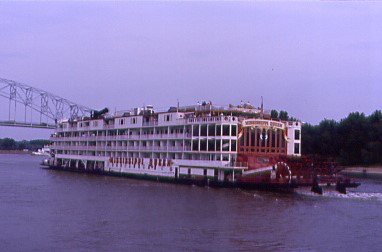
Another red signal allowed us to jump ahead to Hastings, where we set up for the train crossing the Mississippi River. The bridge then lifted and the Mississippi Queen passed underneath the Hastings bridge.
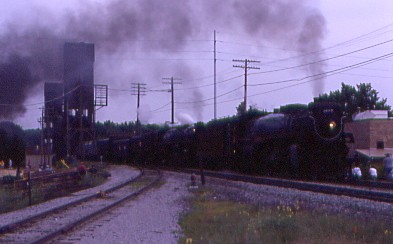
Once the bridge came back down, the double-headed train steamed passed.

Amtrak's Empire Builder, Train 8, followed the steamers then overtook them at East Hastings.
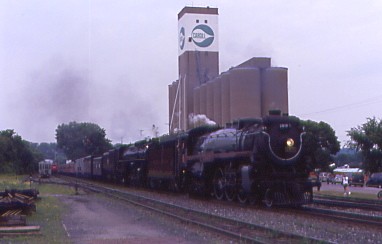
We drove to Red Wing and caught the train arriving into town.
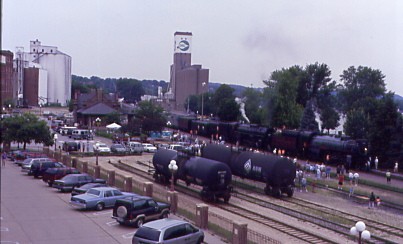
This servicing stop allowed various pictures including one from the parking structure.
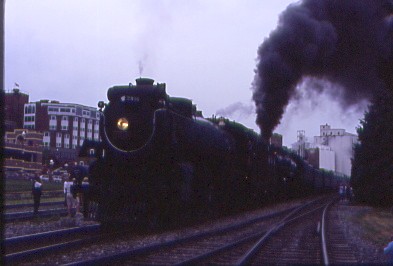
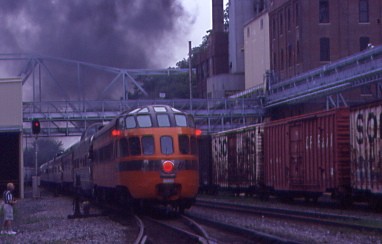
The excursion departed Red Wing after being serviced.
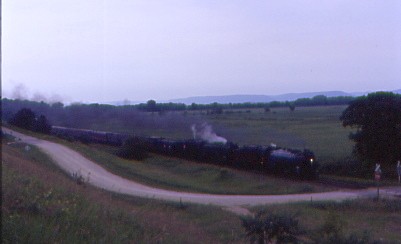
Back on the highway, we caught the train again after Kellogg.

We ran south as the train made a passenger stop at Winona, so drove ahead and found a spot south of Homer, where I met Skip Waters of Dallas, Texas, a reader of my website and a listener of "Let's Talk Trains".
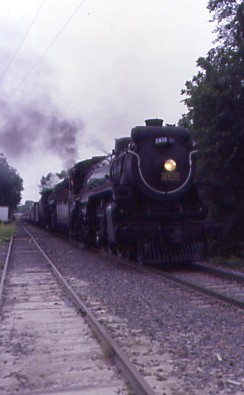
We ran ahead to La Crescent, where I met Skip again catching the train coming in. While the train was being serviced, we went to Subway for lunch and as we were leaving, the train pulled down to be wyed.
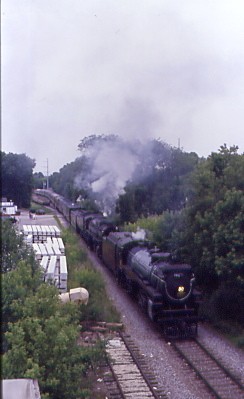
We drove down to a bridge and I climbed up to photograph them reversing, then drove up Appleblossum Hill for a quick look before we went north to our next location.
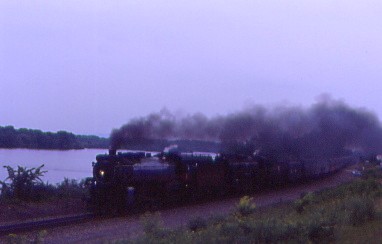
We chose a spot north of Dakota along the Mississippi River then north of Winona, we stopped for an eastbound Canadian Pacific Railway coal train.
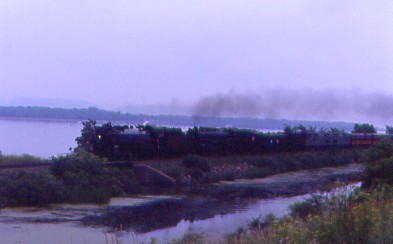
South of Weaver, we caught the train running along the river again. Then the rains came; at first a light shower which we ran through for miles until we came to the really heavy rain. We overtook the train, stopped and then it sped by in this cloudburst. Lightning and thunder echoed off the bluff. This storm was awesome.
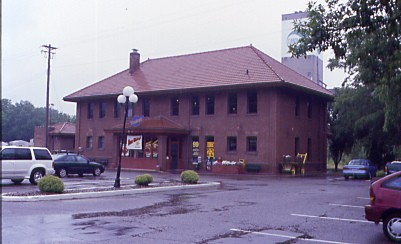
We stopped at Hardee's in Red Wing located in the former Chicago Great Western station built in 1906. There is an excellent railroad display on the second floor.

We stopped by the station as the train was still there then Dennis had the idea that we could go to Lock and Dam 2, where there is a covered platform and we could photograph across the Mississippi River. We arrived there just as a boat was going through the locks which was really interesting, and a BNSF freight ran west before our train came.
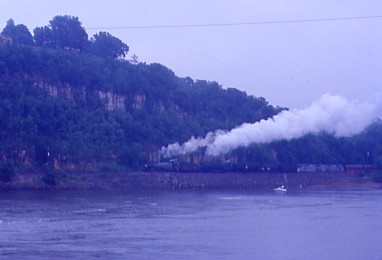
The 2816/261 doubleheader came by in the pouring rain. We stopped for petrol and an Arby's for me while Bob bought takeout from Perkins in Cottage Grove then we drove back in the rain to the Days Inn, ending an exciting chase of the doubleheader. A special thanks to Dennis for all of his knowledge, driving skills and friendship on this trip. This was a great day of railroading and the weather made it more special. We watched "Something about Mary" before we called it a night.
| RETURN TO THE MAIN PAGE |